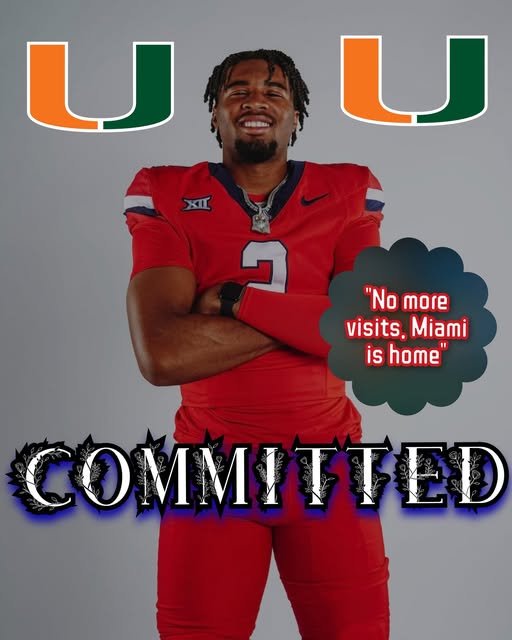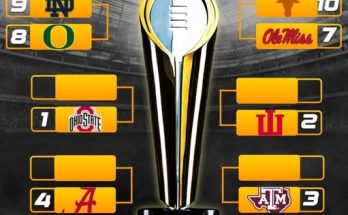Jaden O’Neal’s decision to de‑commit from Oklahoma and commit to the Miami Hurricanes marked one of the most unexpected twists in modern college‑football recruitment. For the last year, the five‑star QB had been viewed as a lock for the Sooners. His original pledge in June 2024 came after a nationwide chase that included powerhouse programs like Alabama, Ohio State, Georgia and Miami. Analysts, coaches, fans—nearly every college‑football insider had come to accept O’Neal’s trajectory as a future Oklahoma star n.rivals.com+7si.com+7247sports.com+7.
At 6‑foot‑3 and roughly 200 pounds, the Mustang (Oklahoma) High School product rapidly ascended recruiting rankings following a standout junior season. He threw for over 3,000 yards, tallied 28 touchdowns, and astonishingly coached his team to a CIF Southern California Division I‑A state championship, all while throwing just four interceptions si.com. Scouts lauded his pocket presence, his touch on the deep ball, his transition to quick‑release mechanics, and the efficient refinement in his play. His offseason development earned him rave reviews—most notably a spot at the Elite 11 regional and the Under Armour Next Camp, where his throwing mechanics drew special praise si.com.
Back in June 2024, his commitment to Oklahoma was seen as a strategic fit. The Sooners were in search of the future face of their offense, and O’Neal’s father, Jerren, noted that the program’s aggressive recruiting approach—especially its rapport with new offensive coordinator Ben Arbuckle—sealed the deal 247sports.com+3si.com+3n.rivals.com+3. The younger O’Neal even transferred to Mustang High to better align with the Sooners’ campus proximity, signaling deeper ties to Norman si.com.
Despite such synchronicity, whispers and doubts lingered. A spring visit to Colorado to watch one of college football’s rising stars, Shedeur Sanders, triggered national buzz. Yet Jerren O’Neal publicly dismissed any notion of wavering commitment—insisting Jaden remained firmly “all‑in” on Oklahoma .
Fast forward to the night of Thursday, June 19, 2025. Out of nowhere, social‑media screens buzzed. News outlets like 247Sports reported that Jaden O’Neal had officially backed off his nearly year‑long commitment. Within minutes, recruits, coaches and analysts were parsing cryptic statements and gauging timelines: had the Sooners truly lost their top signal‑caller? si.com+6247sports.com+6youtube.com+6.
His statement? Brief and to the point: he was reopening his recruitment. Almost immediately, rumors swirled—Miami, Georgia, Alabama and Ohio State were in the hunt. But within 48 hours, O’Neal dropped a bombshell: he was pledging to the Miami Hurricanes, flipping from a team just 200 miles away. First Pérez, then Alabama, then Georgia, then Ohio State—none of their overtures could match what Miami had built in those final hours.
The decision stunned the college‑football world. Oklahoma, still licking its wounds following a rough 2024 season and offensive‑coach turnover, watched as one of its cornerstone recruits slipped away. Analysts framed the shift as emblematic of the intangible forces in football recruiting—intangibles like culture, opportunity, and trust. Miami had apparently convinced O’Neal that his future would grow brighter with the Hurricanes.
To grasp the magnitude, consider the schools that were reportedly in play: Alabama, perennial juggernauts of the SEC; Ohio State, giants of the Big Ten; Georgia, fresh off back‑to‑back national titles; and Miami, a proud program recently emerging from a transitional period. For O’Neal to eschew the current blue‑blood favorites and choose Miami underscored deeper trends: perhaps Miami’s identity, coaching stability, or offensive schematic resonated most with him.
Throughout the process, insiders spread details. During unofficial visits to Florida State and Auburn in April, scouts observed a quarterback with sharpened poise and enhanced mobility. One 247Sports scout noted that while O’Neal had long been recognized as a textbook pocket passer, he “moved a lot more easily in and out of the pocket” si.com. His refined form and athleticism inevitably raised expectations. Such multi‑dimensional capacity made him a rare commodity—and a nationally coveted prize.
That broader talent slate meant O’Neal wasn’t just choosing between uniforms—he was selecting a developmental path. Oklahoma, on the rise under Lincoln Riley’s successors, had its allure. But instability that came with coaching turnover? That was new terrain. Meanwhile, Miami offered something else: a revitalized offensive system, a rich tradition of quarterback excellence—think Ken Dorsey, Brad Kaaya, Teddy Bridgewater—and a promise of playing time. Florida’s tropical backdrop and high‑energy fan base didn’t hurt the pitch either.
Beyond draws of football tradition, Miami’s steely embrace of its roots resonated in recruitment messaging. The school leaned on heritage—Orange Bowl, Chris Fowler, “The U”—while recent seasons under Mario Cristobal had rekindled fire. In private meetings with O’Neal, the Hurricanes likely emphasized their commitment to developing QBs capable of thriving under pressure, in the NFL, and on national television. They painted a picture: become the face of Miami’s next golden era—and be rewarded accordingly.
It’s easy to see why Oklahoma couldn’t hold the line forever. The reality of college football recruiting is brutal: a verbal commitment—even one made for a year—offers no guarantees. Especially with the transfer portal’s growth, NIL deals, Name/ Image/ Likeness money, and coaching volatility, prospects like O’Neal fiercely protect their options.
When Jaden O’Neal reopened his decision, insiders from ESPN to CBS Sports picked up the scent. Early speculation zeroed in on Miami, based on logistics and recruiting momentum. Yet the unexpected nature of his re‑commit underscored two truths: one, even elite prospects pass through Oklahoma’s gates hesitant; two, programs like Miami can and do win high‑profile battles when they play smart, aggressive and creative.
At Miami, the feedback from coaches and recruits was electric. Inside-the-building leaks described an energy‑charged meeting at the Hurricanes’ Coral Gables facilities. According to sources, O’Neal was promised a structured development plan, heavy early playing reps, and partnership with a QB coach whose name has been well‑kept. The pitch highlighted Miami’s recent success in preparing QBs for the next level—and its ability to mix pro‑style and spread concepts in offense.
That kind of detail matters. In today’s recruiting wars, verbal pledges hinge on information. Rivals, 247Sports, ESPN and On3 all noted O’Neal’s refined mechanics, noting that “he’s accurate to all three levels of the field and throws well on the run” si.com. The question for Miami: could they showcase how they’d elevate him beyond even that promising baseline.
In Brian Kelly’s first years at Miami, the Hurricanes have shown capacity to rebuild. While some questioned their QB development, others noted rapid strides. Backup QBs have looked sharp. Practices? Looser around mental reps, more attuned to NFL-style reads than the shotgun drills so common elsewhere.
But the elephant in the room: NIL. Oklahoma, long flush with donor cash, can offer name‑image deals competitive on face value. However, Miami’s local market—South Florida—is among the best in college‑football commerce. Whether a prospective QB can ride jet skis, get featured endorsements, or boost Instagram followings, the Miami scene is ripe. Often, these advantages push recruits one way or another—and Miami’s momentum in that space is only accelerating.
Public reaction was swift. Oklahoma fans on social media expressed surprise, some dismay. Analysts debated whether the Sooners had focused too narrowly on O’Neal. Maybe coaches assumed he was a “done deal” and paused courting others. When their top QB commitment pulled away, they had little plan B at the ready.
Meanwhile, Miami’s social‑media channels exploded with congratulatory posts, while recruiting analysts praised their “win.” The flip came across as evidence of Miami again ascending as a national recruiting program, no longer just another option, but a destination.
Still, O’Neal’s choice won’t guarantee on‑field success. Miami has developed talent well—but the ACC isn’t free of pressure. The Hurricanes must show results soon. If O’Neal develops into an NFL‑ready passer, Miami’s stock in the college landscape rises further. If he flounders, critics will question whether the scheme truly helped him flourish.
For now, though, the gamble is deduced as bold, smart, and timely. O’Neal gains: a high‑opportunity offense, immediate visibility, a lit fanbase—and a connecting corridor to the pro pipeline. Miami gains: an elite‑level prospect at the game’s most important position and a potential face for their next chapter.
Looking ahead, expectations are rising. The national media will be on alert: offers will flow. O’Neal will appear in Miami’s spring practice. He’ll be at summer camps and media days. His progress—not just physically but regionally, how he adapts to the Hurricanes’ style—will be under microscope. Could Miami’s talent‑pipeline promise match his skillset? Will his conversion from standout West Coast passer to ACC leader be seamless? The recruiting world waits.
This de‑commitment and re‑commitment sequence will make ripples. For recruits nationwide, it sends a message: very little is ever final. Even top‑tier verbal pledges can be unraveled by shifting opportunity. For coaches, it reinforces agility: early commitments can be baseline, but sustained recruiting requires persistent work. For fans, it’s a reminder: recruiting drama is its own spectacle.
All that said, the central reality remains: Jaden O’Neal decided Miami was the right next step. A year‑long love‑fest with Oklahoma dissolved in days when Miami reached deeper, talked longer, and painted a clearer future. In doing so, he shifted the narrative—and potentially his career trajectory.
If all goes well, the 2026 season could introduce us to “Hurricane O’Neal.” Imagine him in Coral Gables, leading Miami’s revitalized offense, making deep‑ball connections, showcasing poise, and drawing national attention on a new stage. It’s a tantalizing vision—one that would validate Miami’s aggressive pursuit and vindicate O’Neal’s bold gamble.
Recruiting watchers will note: O’Neal still needs to qualify academically, sign with the school, and then win the QB battle, which—even at Miami—is no small task. But his pledge sends a message: he’s more than comfortable betting on himself.
In the end, the college‑football world looks on with anticipation. Will Jaden O’Neal become Miami’s next great QB? Can he silence critics who question his readiness or resilience? For Oklahoma, it’s an opportunity to learn from the near‑miss and intensify future pipelines. But for now, all eyes turn south, where the Hurricanes—armed with one of the nation’s top quarterbacks—are poised for a potential renaissance.
One thing is certain: the name Jaden O’Neal will be attached to headlines—not just for where he chooses today, but ultimately where he takes this Hurricanes team in the game’s biggest moments. At the crossroads of legacy, performance, and identity, his decision resonates far beyond a recruiting announcement—it reshapes the contours of college‑football momentum as we head toward fall.
That’s the surprising, captivating, and still‑unfolding story of how a nation’s top‑ranked QB shifted the landscape with a single, decisive commitment



